Neurulation - Study guides, Study notes & Summaries
Looking for the best study guides, study notes and summaries about Neurulation? On this page you'll find 212 study documents about Neurulation.
All 212 results
Sort by
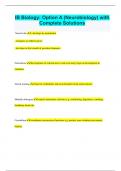 Popular
Popular
-
IB Biology: Option A (Neurobiology) with Complete Solutions
- Exam (elaborations) • 7 pages • 2024
- Available in package deal
-
- R186,67
- 1x sold
- + learn more
IB Biology: Option A (Neurobiology) with Complete Solutions Neural tube - develops by neurulation - elongates as embryo grows - develops in first month of gestation (humans) Neurulation development of a dorsal nerve cord at an early stage in development in chordates Neural pruning removal of dendrites and axon branches from some neurons Medulla oblongata controls autonomic activities e.g. swallowing, digestions, vomiting, breathing, heart rate Cerebellum coordinates unconsc...
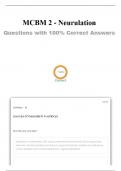
-
MCBM 2 - Neurulation Questions with 100% Correct Answers
- Exam (elaborations) • 66 pages • 2024
- Available in package deal
-
- R149,49
- + learn more
MCBM 2 - Neurulation Questions with 100% Correct Answers
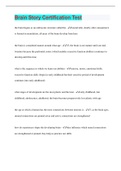
-
Brain Story Certification Test | 40 Questions with 100% Correct Answers | Verified | Latest Update
- Exam (elaborations) • 6 pages • 2023
-
- R196,01
- 9x sold
- + learn more
the brain begins as an embryonic structure called the - neural tube, shortly after conception it is formed in neurulation, all areas of the brain develop from here the brain is considered mature around what age - 25, the brain is not mature until our midtwenties because the prefrontal cortex (which enables executive function abilities) continues to develop until this time what is the sequence in which we learn our abilities - sensory, motor, emotional skills, executive function skills (begi...
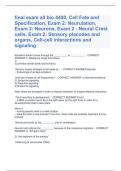
-
final exam all bio 4400, Cell Fate and Specification, Exam 2: Neurulation, Exam 2: Neurons, Exam 2 - Neural Crest cells, Exam 2: Sensory placodes and organs, Cell-cell interactions and signaling
- Exam (elaborations) • 95 pages • 2024
-
- R569,73
- + learn more
final exam all bio 4400, Cell Fate and Specification, Exam 2: Neurulation, Exam 2: Neurons, Exam 2 - Neural Crest cells, Exam 2: Sensory placodes and organs, Cell-cell interactions and signaling Ectoderm doesn't move through the __________ or __________ - CORRECT ANSWER 1) blastopore (frogs and fishes) or 2) primitive streak (birds and humans) Sensory organs all begin in the head as... - CORRECT ANSWER placode - thickenings of surface ectoderm what are 4 types of cell interact...
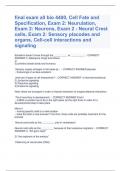
-
final exam all bio Cell Fate and Specification, Exam 2: Neurulation, Exam 2: Neurons, Exam 2 - Neural Crest cells, Exam 2: Sensory placodes and organs, Cell-cell interactions and signaling
- Exam (elaborations) • 95 pages • 2024
-
- R336,15
- + learn more
final exam all bio 4400, Cell Fate and Specification, Exam 2: Neurulation, Exam 2: Neurons, Exam 2 - Neural Crest cells, Exam 2: Sensory placodes and organs, Cell-cell interactions and signaling Ectoderm doesn't move through the __________ or __________ - CORRECT ANSWER 1) blastopore (frogs and fishes) or 2) primitive streak (birds and humans) Sensory organs all begin in the head as... - CORRECT ANSWER placode - thickenings of surface ectoderm what are 4 types of cell interact...
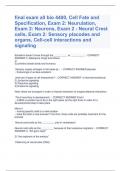
-
final exam all bio 4400, Cell Fate and Specification, Exam 2: Neurulation, Exam 2: Neurons, Exam 2 - Neural Crest cells, Exam 2: Sensory placodes and organs, Cell-cell interactions and signaling
- Exam (elaborations) • 95 pages • 2024
-
- R382,87
- + learn more
final exam all bio 4400, Cell Fate and Specification, Exam 2: Neurulation, Exam 2: Neurons, Exam 2 - Neural Crest cells, Exam 2: Sensory placodes and organs, Cell-cell interactions and signaling Ectoderm doesn't move through the __________ or __________ - CORRECT ANSWER 1) blastopore (frogs and fishes) or 2) primitive streak (birds and humans) Sensory organs all begin in the head as... - CORRECT ANSWER placode - thickenings of surface ectoderm what are 4 types of cell interact...
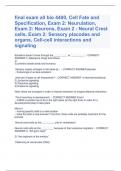
-
final exam all bio 4400, Cell Fate and Specification, Exam 2: Neurulation, Exam 2: Neurons, Exam 2 - Neural Crest cells, Exam 2: Sensory placodes and organs, Cell-cell interactions and signaling
- Exam (elaborations) • 95 pages • 2024
-
- R569,73
- + learn more
final exam all bio 4400, Cell Fate and Specification, Exam 2: Neurulation, Exam 2: Neurons, Exam 2 - Neural Crest cells, Exam 2: Sensory placodes and organs, Cell-cell interactions and signaling Ectoderm doesn't move through the __________ or __________ - CORRECT ANSWER 1) blastopore (frogs and fishes) or 2) primitive streak (birds and humans) Sensory organs all begin in the head as... - CORRECT ANSWER placode - thickenings of surface ectoderm what are 4 types of cell interact...
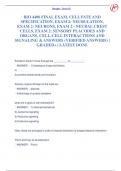
-
BIO 4400 FINAL EXAM, CELL FATE AND SPECIFICATION, EXAM 2: NEURULATION, EXAM 2: NEURONS, EXAM 2 - NEURAL CREST CELLS, EXAM 2: SENSORY PLACODES AND ORGANS, CELL-CELL INTERACTIONS AND SIGNALING & ANSWERS (VERIFIED ANSWERS) | GRADED+ | LATEST DONE
- Exam (elaborations) • 159 pages • 2024
-
- R240,86
- + learn more
Ectoderm doesn't move through the __________ or __________ ANSWER: 1) blastopore (frogs and fishes) or 2) primitive streak (birds and humans) Sensory organs all begin in the head as... ANSWER: placode - thickenings of surface ectoderm what are 4 types of cell interactions? ANSWER: 1) Internal/mechanical 2) Juxtacrine signaling 3) Paracrine signaling 4) Endocrine signaling Note: these are arranged in order of closest interaction to longest distance interaction The 6 word key to ...
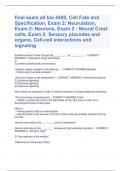
-
LATEST bio 4400, Cell Fate and Specification, Exam 2: Neurulation, Exam 2: Neurons, Exam 2 - Neural Crest cells, Exam 2: Sensory placodes and organs, Cell-cell interactions and signaling EXAM WITH ANSWERS
- Exam (elaborations) • 95 pages • 2024
-
- R270,75
- + learn more
Ectoderm doesn't move through the __________ or __________ - CORRECT ANSWER 1) blastopore (frogs and fishes) or 2) primitive streak (birds and humans) Sensory organs all begin in the head as... - CORRECT ANSWER placode - thickenings of surface ectoderm what are 4 types of cell interactions? - CORRECT ANSWER 1) Internal/mechanical 2) Juxtacrine signaling 3) Paracrine signaling 4) Endocrine signaling Note: these are arranged in order of closest interaction to longest distance interactio...
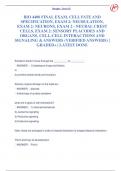
-
BIO 4400 FINAL EXAM, CELL FATE AND SPECIFICATION, EXAM 2: NEURULATION, EXAM 2: NEURONS, EXAM 2 - NEURAL CREST CELLS, EXAM 2: SENSORY PLACODES AND ORGANS, CELL-CELL INTERACTIONS AND SIGNALING & ANSWERS (VERIFIED ANSWERS) | GRADED+ | LATEST DONE
- Exam (elaborations) • 159 pages • 2024
-
- R345,50
- + learn more
Ectoderm doesn't move through the __________ or __________ ANSWER: 1) blastopore (frogs and fishes) or 2) primitive streak (birds and humans) Sensory organs all begin in the head as... ANSWER: placode - thickenings of surface ectoderm what are 4 types of cell interactions? ANSWER: 1) Internal/mechanical 2) Juxtacrine signaling 3) Paracrine signaling 4) Endocrine signaling Note: these are arranged in order of closest interaction to longest distance interaction The 6 word key to ...

Did you know that on average a seller on Stuvia earns R4500 per month selling summaries? Hmm, hint, hint. Discover all about earning on Stuvia


